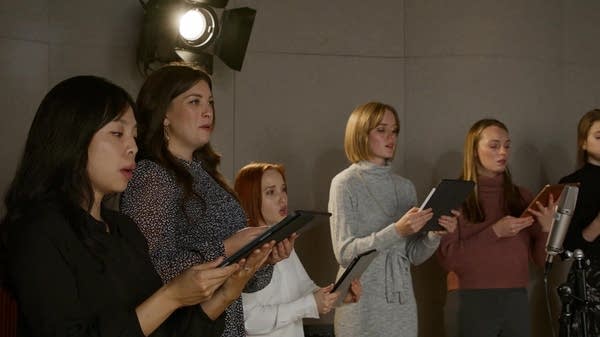You would not believe how loud it was.
In a small schoolroom at Fort Snelling last month, people were singing hymns from the 18th century with such gusto that this girl, raised in the Lutheran choral tradition, felt a wave of intimidation approaching the doorway. Lutherans sing, but definitely not like that.
That's because the group was singing from The Sacred Harp.
Every summer, people gather at Fort Snelling to do something that is becoming increasingly rare in our society: sing together in community.
Shape note singing is a music rooted in the churches of colonial New England and Appalachia. In the 1600s, when few people read music, a new system was created to revive congregational singing in early America. Every note was assigned a shape, and each shape had a syllable: fa, sol, la, mi. People memorized the pitch for each shape and syllable.
The first collection of these hymns was in a book called The Sacred Harp. Instead of sitting in pews, they sang in a hollow square, every side assigned a part. Someone in the middle stands keeping time and leading the song, and everybody gets this chance, no matter age or ability.
(Many listeners first became aware of the unique sound of shape note singing when it was featured on the soundtrack to Cold Mountain, a film set during the Civil War.)
At Fort Snelling last month, about 20 people were regular Sacred Harp singers, and passing visitors joined in throughout the afternoon. I'd been to the annual event once before, and learned more about shape-note singing from a college music history class; but a newcomer might find it overwhelming. Luckily, a singer gave a short overview.
This gentleman said that the Sacred Harp style encourages singing with "full heart and full voice," no doubt reflecting the original theological intent: to "make a joyful noise to the Lord." What results is an unbridled wall of sound sure to rattle the gates of Heaven. It certainly cut through the Fort's cannon firing demonstration.
I asked some of the singers at Fort Snelling what brought them to Sacred Harp. The responses included a love of singing, an interest in history, and an ad in the newspaper. The community it created is what kept them. The group that meets regularly at the University Baptist Church in Minneapolis contains about as many gray-haired folks as it does 20-somethings, retirees and professionals as much as students. They host day-long singing conventions that bring in people from all over the U.S., sometimes the globe.
In this day and age, you simply don't see that kind of joyful diversity in many places. I say this as a lifelong choral singer: Sacred Harp reaches people in a way that's different than choral music, because the doing is the thing, not performing or perfecting a sound. There is honor and dignity in the pursuit of perfection—but the sole act of doing, singing Sacred Harp offers the same gifts as being in a performing choir: community, friendship, being steward to a tradition that has endured through generations.
Whether you think you have a good voice or not, that is not the point. It's that you have something to give at all.
Emily Feld is a recent graduate of Concordia College, where she studied piano performance. She is an active chamber musician, singer, and composer of choral music, and is excited to see where those three passions take her in life.
Love the music?
Show your support by making a gift to YourClassical.
Each day, we’re here for you with thoughtful streams that set the tone for your day – not to mention the stories and programs that inspire you to new discovery and help you explore the music you love.
YourClassical is available for free, because we are listener-supported public media. Take a moment to make your gift today.












